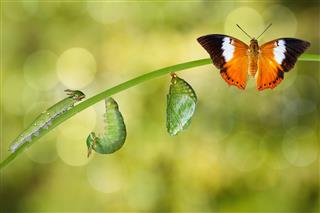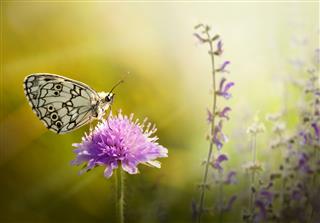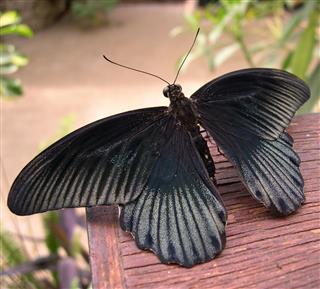
How does a caterpillar that comes out of a tiny egg, metamorphose into a butterfly with magnificently artistic designs on its wings? This article will tell you about the four growth stages of a butterfly, and the extraordinary transformation that it goes through.
We delight in the beauty of the butterfly, but rarely admit the changes it has gone through to achieve that beauty. – Maya Angelou
A butterfly is an ideal example of the magic that lies in the process of transformation. Even though the stages may seem to be difficult and isolating, the end result brings forth freedom and beauty. Every butterfly is an ugly caterpillar before it takes its beautiful form. A caterpillar struggles to break open the cocoon and come out in the open, to be what it is destined to be, a personification of beauty and vibrancy – a butterfly. It becomes a butterfly, a symbol of subtlety, beauty, and color! In the following sections on the 4 growth stages of a butterfly, we shall see how a tiny little egg bears forth an unattractive caterpillar, which then metamorphoses into an adorable and elegant butterfly.
The Four Stages in a Butterfly’s Life

Stage – 1: The Egg
The initial stage in the life of a butterfly is a tiny egg, which may be so small, that it may not be visible to the naked human eye. The egg has an outer shell called chorion, which protects the larva inside. It has an inner lining of wax which maintains moisture. The eggs are often laid on the outer side of the leaves of the host plant, and are attached to the plant with a gum-like chemical secreted by the female butterfly. This chemical tends to harden rapidly, sustaining the position of the egg.
Different species lay different number of eggs at a time. Also, the shape and size of the egg may vary depending upon the butterfly species. The eggs may take a few weeks to hatch, depending upon the time when the eggs are laid. If the eggs are laid around the winter season, then they may go into the resting phase (known as diapause), and hatch only in the spring season. Some northern species of the butterfly lay eggs in the spring, which are hatched during the summer.
Stage – 2: The Larva (Caterpillar)
The next growth stage of a butterfly is the larval stage. Larvae (plural of larva) are also known as caterpillars. After hatching out, the caterpillar, interestingly, eats its egg case. Larva has three main sections in its body – head, thorax, and abdomen. It has a set of real legs accompanied by a set of five false legs, which are called prolegs. It has six eyes but does not have a well-developed eyesight. It respires through the holes on the sides of its body. A newly hatched caterpillar is minute, but it eats a lot and grows manifold in size.
Caterpillars can be dull-colored or may have striped bodies of bright colors. In the larval stage, tiny wing disks appear on the thoracic segments. They may be hairy or may have bristles. As it grows, a caterpillar continues shedding its skin to meet its body’s growth. When the caterpillar is ready (about 11/4 inch), it hangs itself on the underside of a leaf, forming a J shape, and starts proceeding towards the next stage of its life.
Stage – 3: The Pupa (Chrysalis)
During this stage, the larval skin comes off. The time period that elapses between the shedding of skin is called instar. After the final instar, a pupa emerges. A spiny part appears at the end of the larva’s abdomen. This spiny part is known as the cremaster, which is attached to the surface of the leaf. The pupa hangs from the cremaster. In fact, even a baby butterfly hangs from it until it is confident enough to spread its wings and fly.
Some pupae are capable of moving parts of their abdomen to produce sounds as a defense against predators. During the transformation, a complete reassembly of cells results into the formation of a butterfly. Pupa may appear to rest, but it undergoes a major reform during this stage. The beautiful patterns of the wings are formed within the pupa, in this stage.
Stage – 4: The Adult Butterfly
An adult butterfly emerges with wings folded up. It has a head, thorax, and an abdomen. It has six legs but it curls up two of them. A butterfly has a long tongue that is used to suck nectar and water. It is called proboscis. It has two sets of wings – hind wings and fore wings – which are covered with scales.
Mating and reproducing characterize this stage. Female adults lay eggs to start the life cycle again. Depending upon the specific species, adult butterflies live for a time period that varies between a week to a year.
* Note: The time spent at each of the stages can vary depending on the season of laying and the specific species of the butterfly.
The butterfly counts not months but moments, and has time enough. – Rabindranath Tagore
What is most amazing about the life of this beautiful creature is its grit to live and transform itself from something that crawls on a surface – to something that can spread its beautiful wings and fly high to freedom. A short life, that begins with an almost invisible little egg – after going through a magical transformation – becomes a subject of marvel, beauty, and inspiration. That is the life of a butterfly – live not by days, but by moments; not by permanency, but by dynamism; not by doubts, but by a belief – that whatever is happening, is happening for you to experience something beautiful.




















































